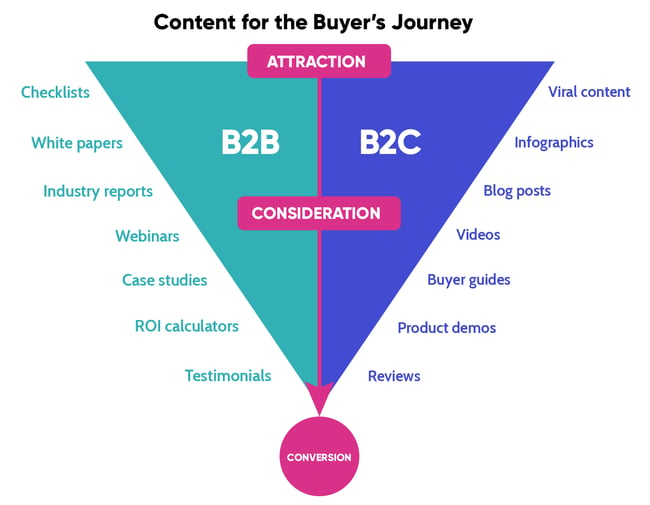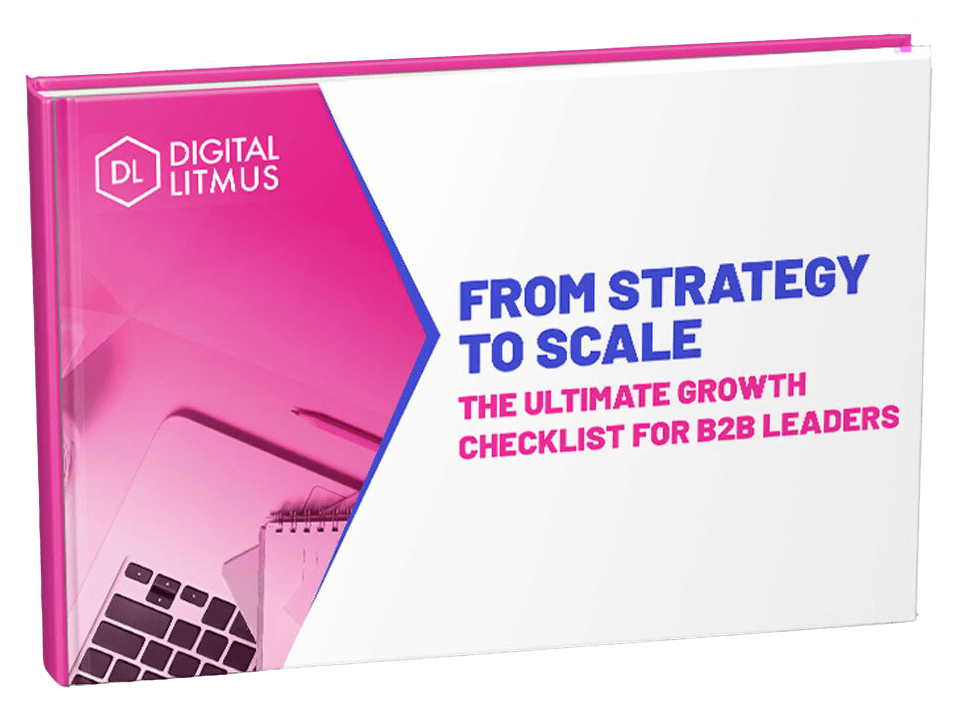The internet is full of advice on B2B lead generation strategies. Some of that advice is great. Some of it’s bad to the point of potentially losing you money if you follow it. And some of it is ludicrously out of date.
For example, one very common statistic is that the “best three lead sources for B2B companies” are SEO (14%), email marketing, (13%), and social media (12%). Unfortunately, this information comes from HubSpot research dating back to 2013 – though you’ll see it still quoted in articles and blogs from 2021.
Whether you’re just launching a new SaaS product or you’re struggling to fill your sales pipeline consistently, you want actionable, simple guidance on what to do. And you want it to be up to date and accurate. That’s why we’ve put together the following B2B lead generation quick start guide to help, based on our years of experience of B2B lead generation.
The first part of this guide gives a brief rundown of what B2B lead generation is. Then we’ll explore the effectiveness of some of the most common B2B lead generation strategies as ranked by marketers. The third part of the guide highlights some less common strategies to consider.
It’s also important to remember that just because certain strategies work for some businesses, that doesn’t mean they’ll work for you. You also can’t do more than two or three of these strategies well at any one time. So at the end of this guide we’ll go through our hard won tips on how to choose the most effective B2B lead generation strategies for your business specifically.
What is B2B Lead Generation?
According to HubSpot, B2B lead generation is “the process of attracting prospects to your business and increasing their interest through nurturing, all with the end goal of converting them into a customer.”
Doing lead generation well means building a relationship with potential customers by showing them you understand their business problems and how to solve them. It usually means doing this over an extended time – or sales cycle – because B2B sales involve multiple influencers within a business and can represent a significant and risky investment.
The lead generation process involves attracting prospects to your website, where they give you their contact information in return for something of value – this often takes the form of useful information. Once you have their contact details, you continue to communicate with them in ways that deepen their trust and hopefully get them to buy one of your products or services.
Why do so many businesses struggle with lead generation?
The consensus is that lead generation is tricky. 61% of marketers say they consider generating leads to be their biggest challenge.
Many B2B businesses struggle with lead generation in the early stages because they don’t follow a process. They often also try multiple different strategies without sticking with one long enough to test it properly. They also tend to think tactically rather than strategically. (Blogging, for example, is a tactic, not a strategy.)
B2B lead generation requires strong alignment between marketing and sales as well, since the sales team usually closes the sale once marketing have captured and nurtured the lead. Lastly, many companies just don’t know where to start when it comes to choosing a strategy. This is where part 2 of our guide comes in.
The 6 Most Common B2B Lead Generation Strategies – Just How Effective Are They (According to Marketers)?
According to various surveys of marketers and other reputable marketing sources, the following is a list of the most common B2B lead generation strategies ranked in reverse order of effectiveness.
Strategy #6: PPC Advertising
Pay per click, or PPC, is 'a form of advertising that allows you to pay a fee to have your website on the search engine result page (SERP) when someone types in specific keywords or phrases to the search engine. The SERP will display the ads you create to direct visitors to your site, and the fee you pay is based on whether people click your ad.'
PPC ads produce fast results, allow you to target your ideal customers, and can help improve your search engine optimisation and content strategies. According to Get Response, only 26% of marketers rate PPC as either good or excellent. This is probably because PPC can quickly get very complex and very expensive. It can also be hugely competitive, depending on the niche in question. Although many B2B firms generate leads this way, many of them struggle to do so at a profit.
Strategy #5: Paid Social Media
This is similar to PPC, only using social media. Examples of this would include display advertising on LinkedIn or using LinkedIn Message Ads – which used to be called Sponsored Inmail. While LinkedIn ads can be very effective due to the targeting options available, they also come with several potential drawbacks:
- It’s hugely competitive.
- LinkedIn costs are relatively high, with the average cost per click (CPC) at around $5.74, and the cost per conversion estimated at $90.
- You have no guarantee of how many leads you’ll generate.
- There is limited campaign reporting, compared with PPC.
Of course, LinkedIn is not the only outlet for paid social media. Facebook can also work well for lead generation, and is less competitive in the B2B space than LinkedIn. Facebook allows you to collect contact information within the platform, avoiding the step of attracting prospects to your website first.
In contrast to LinkedIn, Facebook is one of the cheapest social media ad platforms, with an average CPC of only $0.97 (depending on which data set you use). This might make it a better place to experiment with paid social media if you are tempted to give it a try.
Strategy #4: Content Marketing
80% of business decision makers prefer to get information from an article than an ad, according to Marx Communications. At the same time, 33% of B2B marketers rate content marketing as good or excellent.
The Content Marketing Institute defines content marketing as “a strategic marketing approach focused on creating and distributing valuable, relevant, and consistent content to attract and retain a clearly defined audience — and, ultimately, to drive profitable customer action.”
Content can take many forms, and can be used at the beginning of the buyer’s journey to attract their attention, in the middle phase of the journey to increase their trust, and at the end to convert them to a lead.
Here are some content examples:

Common forms of written content such as whitepapers, case studies, reports, and blog posts can all be used as part of an effective content marketing strategy, as can webinars, explainer videos, and product demos.
According to HubSpot, the top media formats B2B marketers plan on investing more into in 2022 include:
- Case studies (42%)
- Interviews (34%)
- Ebooks (29%)
- Images (25%)
- White papers (15%)
Strategy #3: Search Engine Optimisation (SEO)
Search engine optimisation is “the process of optimising various front-end and back-end components of your website so that it ranks in search engines and brings in new traffic,” says HubSpot.
33% of B2B marketers rate it as good or excellent. It is a powerful strategy because people trust high organic rankings on Google and other search engines; according to imFORZA, search is the number driver of traffic to content sites, beating social media by more than 300%, while 70-80% of people ignore paid search results, preferring to click on organic search results.
However, the reason this might not score higher with B2B marketers is because ranking for certain search terms can be highly competitive. Progress usually takes months rather than weeks – especially for young websites with less authority. And, as with PPC, this strategy can be highly complex, with many pitfalls. This is another area where consulting with an experienced B2B lead generation agency makes a lot of sense before jumping in feet first.
Strategy #2: Organic Social Media
Social media marketing is a great favourite among many B2B marketers, with 39% rating it as good or excellent. At the same time, 82% of B2B markers report finding the greatest success on LinkedIn.
As HubSpot puts it: “Social media is a powerful tool for building brand awareness, giving your company an online personality, and humanizing your business — all very powerful factors when it comes to marketing and connecting with potential customers.”
It’s a great way of sharing content and promoting your thought leadership, expertise, or fantastic customer feedback. According to HubSpot, the social media marketing strategies B2B marketers plan on investing more into in 2022 include:
- Influencer marketing (71%)
- Audio chat rooms (38%)
- Branded challenges (32%)
- User-generated content (30%)
- Augmented reality (30%)
Yet there are some pitfalls here. Trying to drive traffic from your social media accounts to your own website has become more and more difficult in recent years, as social media firms try to keep visitors on their site as long as possible so they can see more paid ads.
When looking to try organic social media marketing for the first time – or improve your results – it makes sense to get some advice from a B2B lead generation agency first, so you avoid wasting time on tactics that don’t work.
Strategy #1: Email
Email marketing is consistently rated the most effective B2B lead generation strategy by B2B marketers. 47% of marketers in this survey rated it as good or excellent. And no wonder – email offers an average return on investment of 36:1, while email “typically produces better results than social media”.
Despite all this, many B2B marketers can’t achieve good results with email. Again, this is usually down to not following a process, not sticking at it long enough, not testing different messages and approaches, or simply not knowing how to create effective emails.
Want to ignite your lead generation and drive revenue growth? Explore our Demand Generation services and how we can help your business thrive!
Less Common B2B Lead Generation Strategies to Consider
You’ve now seen the most common B2B lead gen strategies ranked by perceived effectiveness. However, you need to take these rankings with a pinch of salt. Not every strategy that works for others will work for you, and the most popular strategies can suffer from being so popular that everyone tries to do them, thus reducing their effectiveness. One way to stand out from the crowd is to try strategies that are less common or even actively neglected. The below strategies are listed in reverse order of potential effectiveness and cost-effectiveness based on our experience.
Podcasts
Everyone and his dog has a podcast these days, as a client once said to us. This is true. There’s no point trying to set up your own podcast. Instead, you should look around in your sector and find those podcasts that are already popular and get yourself interviewed on them. If you have an interesting story, a genuinely new or interesting product, or you have something relevant to say about current trending topics such as diversity in the workplace or sustainability, there’s a good chance you can get a spot. As long as you approach podcasters in the right way.
Video
Lots of people like video but many people do it badly. They give up after producing a few videos that don’t get traction, or they lack the budget to do it well. Building a branded Youtube channel is so difficult that it’s probably not worth the effort for most SaaS companies. However, if you can make a series of short explainer videos about how your product works that you place on your website, many prospects will find that engaging.
If you can have a few soundbites or short interviews with key management on your About Us page, that can increase conversations – because people like to buy from people rather than faceless corporations. Lastly, short punchy videos for posting on LinkedIn can be a great way of increasing engagement there. Videos of under two minutes tend to do better, as do videos with lower production values!
Events / Webinars
Yes, I know. After two years of lockdown, people are webinared out. But this could be a potential opportunity, as many organisations say they plan to wind down their webinar activity. If you have someone charismatic who comes across well on video call, or you have a really compelling proposition that solves an urgent problem for your customers, webinars will still work.
On top of that, physical events were a great way of attracting potential leads pre-Covid, and are likely to become so again. Events are great for inviting well-regarded guest speakers, boosting credibility, adding interest to an otherwise dry technology product, and generating dozens if not hundreds of leads for your sales teams.
Direct Mail
Direct mail is now so rarely attempted in B2B that most marketers now have never worked on a direct mail campaign. Yet there are members of this agency who have seen the benefits first hand. Direct mail is when you post a letter or other physical object to carefully targeted individuals and ask them to take a specific action which will initiate your relationship and lead to them becoming a lead.
A few years ago, one of our copywriters worked on a direct mail campaign going out to people in insurance that got 40% of those mailed to attend a cocktail event in central London. The event itself generated over 60 sales leads.
Another of our copywriters worked on a direct mail campaign for a Japanese brand selling to large corporates across Europe that got an 80% response rate. Not kidding – 80%. That is, 80% of those who received the package called the number given to speak to a salesperson.
Direct mail can generate a huge ROI – if you know what you’re doing.
Word of Mouth / Referrals
This is by far the most cost-effective B2B lead generation strategy there is. This is in fact how many B2B SaaS companies get their first clients, but they either move on and forget about this strategy, or they never turn it into a repeatable process.
The concept is simple: ask your existing customers to refer you to a contact they know. Most people in any given industry have a network of people that they trust. Once they trust you enough to deploy your solution, ask them to recommend you. Some marketers offer an incentive for this in terms of a discount or similar, but this is often unnecessary – especially if your product is good.
How to Choose the Most Effective B2B Lead Generation Strategies for Your Business
Not every strategy works the same for everyone. More importantly, no company can execute more than three lead gen strategies successfully at once without diluting their efforts. So how do you know which strategies will work best for you?
Tip #1: Play to Your Strengths
If you have an extremely articulate CEO or other senior leaders, consider getting them exposure, via webinars, events, podcasts or short video clips. If you have some skilled content marketers on your team, focus on that. Perhaps you have marketers with a lot of experience of running paid ads: make use of them. Don’t just attempt the strategies you think you should; start with the ones you’re likely to enjoy and be good at.
Tip #2: Know Your Customers!
In financial services, this is a regulatory obligation, but all sectors, all companies, and all marketers should take this just as seriously. If you do not understand your customers’ needs, desires, pain points, prejudices, or assumptions, you will never be able to gain their trust. Make sure you develop some B2B buyer personas – and check out our recent article on how to do that right here.
Tip #3: Know Your Customer Lifetime Value (CLTV)
Every company should know this anyway – especially if you’ve raised any investment. So I won’t look silly by telling you how to calculate it. Just make sure that you do it, as you’ll need this to set your marketing budget.
Tip #4: Set Your Marketing Budget Using Your CLTV
Once you know your real or projected customer lifetime value, subtract the cost of delivery and a proportion of your running costs. What’s left is how much you can afford to spend on acquiring each customer if you want to break even. Multiply that by the number of customers you want, and that’s your marketing budget.
Tip #5: What can you Afford to Spend and Where are you Likely to Get the Highest or Fastest ROI?
Now you know what your overall budget can be, look at the list of B2B lead generation strategies and pick the three that appeal to you as fitting what is most likely to appeal to your customers, and what you think you could execute most effectively given your existing skill set.
Tip #6: Focus on No More than Three Strategies at a Time – Maximum – and Test Them Consistently Over a Prolonged Period
This one is pretty self-explanatory. Very few companies can execute more than three lead generation strategies effectively, so don’t try. And try to execute each strategy for at least six months – and preferably longer. That’s how long it takes to start generating enough data you can analyse and then use to test different approaches.
Cutting Through the Complexity
We hope you found this short B2B SaaS lead generation guide useful. You should now have a good idea of what B2B lead generation is, which lead gen strategies are working well for others – and why – and know how to work out which of them is most likely to work for you.
Of course, B2B lead generation isn’t easy. This is why so many B2B marketers struggle to do it well, as we’ve already seen. For some, the best option to cut through the complexity is to look into hiring a specialist B2B lead generation agency.
At Digital Litmus, we offer a free demand generation assessment. You can speak to our strategists about your lead generation challenges and we’ll help come up with tailored strategies based on our extensive experience. It’s completely free – apart from your time – and there’s no obligation. Find out more here.

Are you a B2B company looking to accelerate growth?
Our connected sales, marketing, and HubSpot agency services might be just the ticket. Get in touch for your free growth assessment to find out how you can accelerate business growth today.





